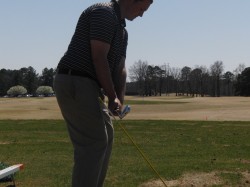Can you have too much flying wedge?
Thursday, April 21st, 2011Certain teaching circles have brought exposure to several Golfing Machine concepts recently, most notably the concept of the flying wedge. If you are unfamiliar with this concept the [right forearm] “flying wedge” is the angle created by the right forearm and right wrist bend and the right elbow and clubhead which allows the clubhead to trail the hands. It also plays an important role in controlling the clubhead line of flight as well as sweet spot control. Other topics in the The Golfing Machine have been controversial and highly criticized, most notably whether or not one can have too much lag. One can argue the same over the topic of the right forearm flying wedge.
From what I have been witnessing, the concept is being missapplied. Watching instructors explain to students that they need to hold the flying wedge, or that they need more flying wedge they are really referring to right wrist bend which is part the flying wedge. Wrist bend is an important piece of the flying wedge but there comes a point in which too much right wrist bend will actually become a fault as opposed to a solution. Why? Depending on the grip type and hand location at the address position, the hands may or may not move further forward from this position at impact and change the degree of bend in the right wrist. Too much right wrist bend will lead to a decrease in the effective mass hitting the golf ball (moment arm) and lead to contact issues becuse of the shortened radius, as well as the sweet spot moving off plane and an Angle of Attack that is too steep.
So now your asking, “How do I know if I have just enough amount of right wrist bend and right forearm flying wedge?” And the answer is simple. Look at your left arm flying wedge! The left arm flying wedge is the angle formed by the left arm and club. From a face on position at impact, the left arm and clubshaft should be in a straight line. The two wedges should compliment each other. If the left wrist starts to arc or bow (flex inward), then there the too much right wrist bend!


